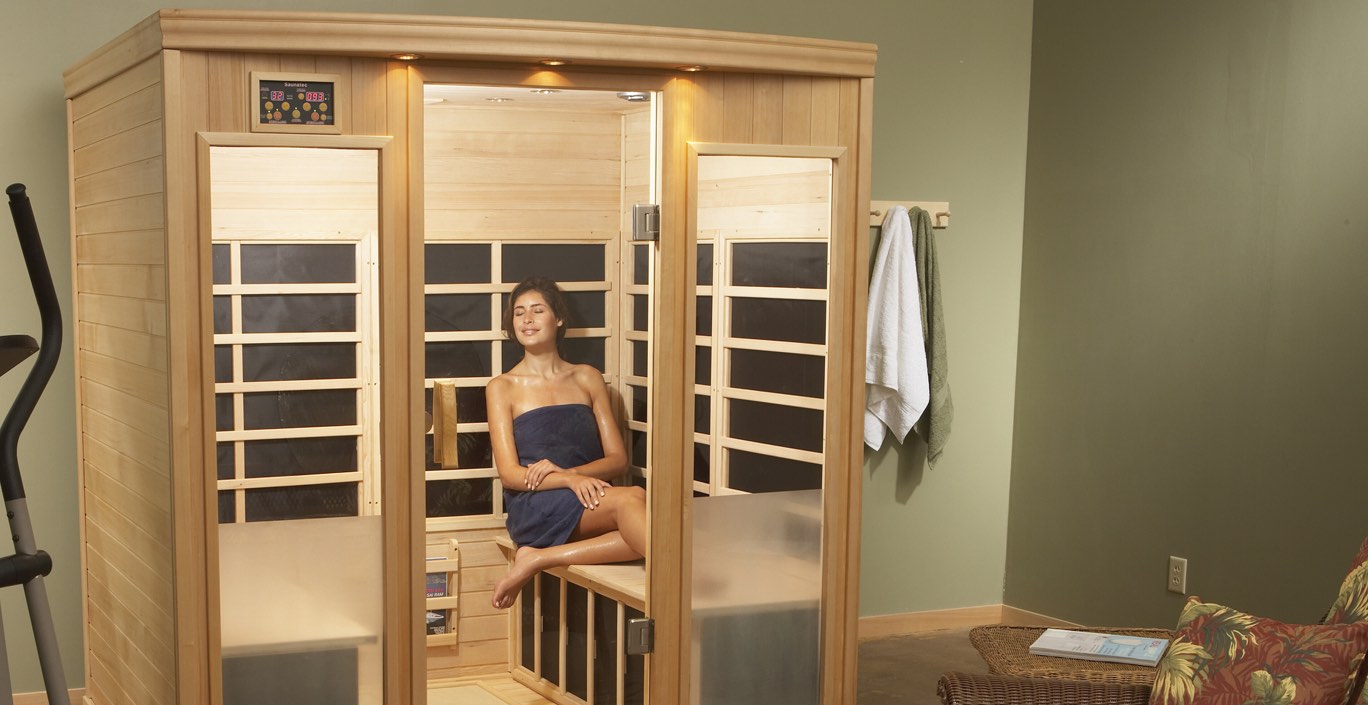Great Atlantic Hot Tubs
Skip to content

Traditional Sauna or Far Infrared Sauna. What’s the Difference? You’ll need to know in order to decide which is the right product for you.
Traditional saunas and far infrared both use heat to help promote sweating to relax your muscles, soothe joints and cleanse your skin. So, when it comes to choosing one over the other, it’s basically a matter of preference. They do, however, differ in 4 primary ways:
- the type of heat used
- how the heat is generated
- the construction of the bathing “space”
- where the sauna can be located
Let’s examine the differences between them and the factors you should considering when purchasing one of these products.
SAUNA TYPE
Saunas typically provide a dry, high heat and low humidity environment. The sauna room itself is a structure constructed of soft, close grain woods with wooden benches for seating or reclining. It can be small enough for one person or as large as room size. As an example, the smallest Finnleo infrared sauna is nine square feet and custom cut sizes are available in excess of 96 square feet. While a traditional sauna can be installed indoors or out, an infrared sauna is an indoor installation only.
TRADITIONAL SAUNA
In a traditional sauna, the air is heated to a high temperature (150 – 175 degrees) using a heater element covered in rocks. As the rocks (and the wood) in the sauna heat up the air, the air heats up the bather. A bather’s body is essentially heated, indirectly, from the outside in by the hot air. The bather can add some moisture into the environment by sprinkling water over the rocks (but much less steam is created than in a steam bath). Because of the high temperatures and hot air, a bather cannot stay in the sauna for long periods of time.
INFRARED SAUNA
With an infrared sauna, an electric heating element generates radiant heat in just a few minutes. The rays, or energy, generated by the heating element is directly absorbed into the bather’s body causing the person to sweat as their temperature rises. These rays cause the heat to more deeply penetrate the body, more quickly and at lower temperatures (120 -130 degrees) than is needed in a traditional sauna. This can make an infrared sauna a more comfortable bathing experience for people sensitive to the higher temperatures typical in a traditional sauna. And, an infrared sauna is particularly effective at providing relief for individuals with skin conditions, like eczema or psoriasis, because of the way the heat is generated. Because it is so quick to heat up, it’s especially effective as a pre-workout warm up.
A traditional sauna uses more electricity than an infrared sauna. It takes more time to heat up than an infrared sauna. And, the maintenance required for the two differs as well. Traditional saunas must be cleaned and disinfected on a regular basis while an infrared sauna can be cleaned with a damp cloth.
INFRASAUNA
What if you can’t decide or want the benefit of both types of bathing experiences? Some people may prefer infrared bathing in the morning to start their day and use a traditional sauna as an evening activity. In that case, an InfraSauna from Finnleo may be the best choice because the best of both types of heat baths is combined into one room. While only one heat source can be used at a time, a couple can use the far-infrared panels first to allow the person who enjoys lower temperatures to have his or her experience. When the first person is ready to exit the sauna, the heat source can be changed to traditional sauna and the sauna is ready for the second bather in no time.
SAUNA BUYING TIPS
In a sauna, your purchase decision really boils down to 3 things: 1) the construction 2) the heater and 3) who you buy from (and the warranty provided).
THE CONSTRUCTION
- In a sauna, the wood used to build the walls, both inside and out, should be a strong wood that is stable, resistant to warping and decay and feels good to the skin. That’s why red cedar and hemlock are great choices for a sauna. (Note: people with allergies or asthma may find hemlock a better choice for them if you have sensitivity to the natural oils found in cedar).
- Inspect the sauna to see how it is put together. Make sure that the sauna walls and benches do not contain any lesser quality “filler” woods.
- Look at the thickness of the sauna walls. This will not only impact the durability of the sauna but also affects the insulation value and the time it takes to heat up.
- And, a well constructed sauna will use tight fitting joints and screws rather than adhesives like glue, which can release unhealthy gases. So, be sure to look for a sauna, like that from Finnleo, which is certified VOG-free.
THE HEATER
- A heater for a traditional sauna should be constructed of stainless steel elements. They should have a large quantity of rocks in direct contact with the heating elements and be appropriately sized for the space.
- Infrared saunas emit Electro Magnetic Radiation (EMR) and Electric Field(EF) radiation. This is not harmful in the low doses used (and is safely used in hospitals today). Even so, you’ll want the lowest possible dose and Finnleo offers “Pure Infra™”, its exclusive infrared sauna technology that nearly eliminates the radiation altogether to provide an even healthier detoxification experience. In fact, Finnleo has the only infrared sauna technology that has tested radiation levels below even tough Swedish standards.
- The most common types of heaters in an infrared sauna are ceramic and carbon. Carbon panels are quicker to heat than ceramic panels. With a ceramic heater, you may experience cold spots in the sauna where no infrared heat waves reach the body. Or, you may experience hot spots, when seated directly in front of an infrared heater. That’s why a carbon panel heater is a better choice than a ceramic heater for giving you more even heat distribution. In a carbon panel heater, the surface area of the heating panels dictates how well the heat is disbursed. So, the bigger the surface area, the better. This is one area where you don’t want to cut corners. For example, an infrared sauna with heating panels on all sides (to the front, back and side of you, as well as under you) will provide the most even heat disbursement.
WHO YOU BUY FROM
Whichever heat bathing product you decide on, who you buy it from should be an important factor in your decision making process.
Take the time to research how long the company been manufacturing the products they are promoting. Do they have a track record of quality, performance and product innovations? A strong indicator will be certifications and awards they have received. The heater in your sauna should be certified as safe and reliable from an independent agency/organization such as Underwriters Laboratories® or ETL (Intertek Testing services).
You’ll also want to look carefully at the manufacturer’s warranty. For example, an infrared sauna should come with a lifetime warranty on the heater. All of a sauna’s electrical components, including the controller, should be covered under warranty. And, the wood in a sauna should also be covered by the manufacturer’s warranty. This coverage is important protection for you in the unlikely event that the wood used in the construction of your sauna was not properly dried in the construction process. Coverage of all of these items is a good indicator that the manufacturer will stand by their product.
For all of the above reasons, Great Atlantic Hot Tubs, Pools & Saunas carries Finnleo saunas and our team is eager to help you understand the features to look for in a sauna, either traditional or infrared, that will ensure a great sauna bathing experience. And, when you come in to the store, you can “test” drive a sauna to feel the Finnleo difference.






